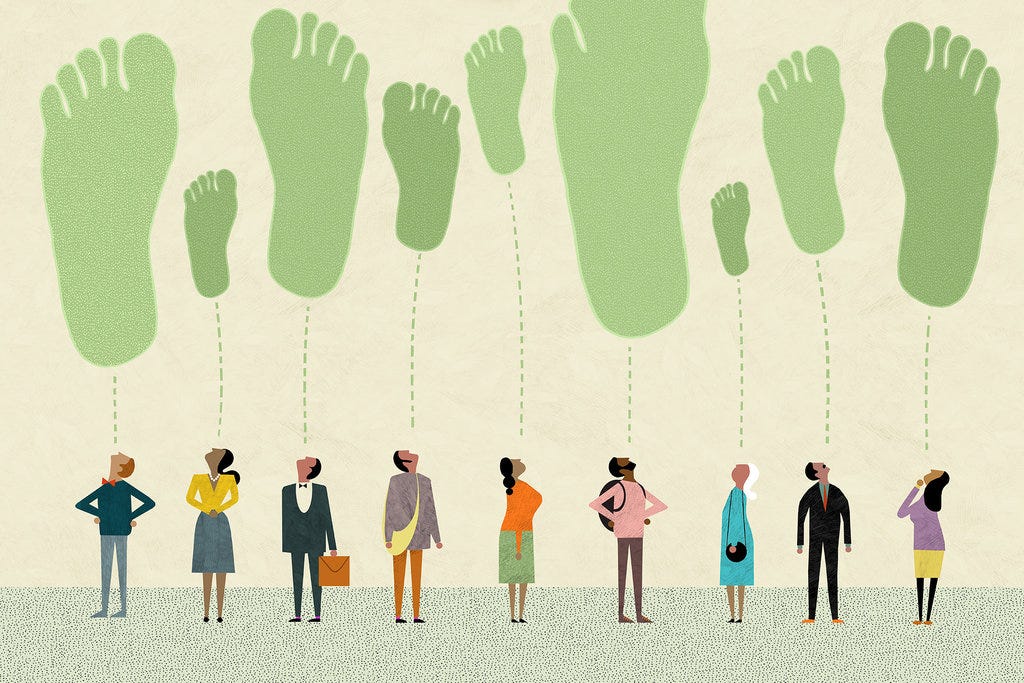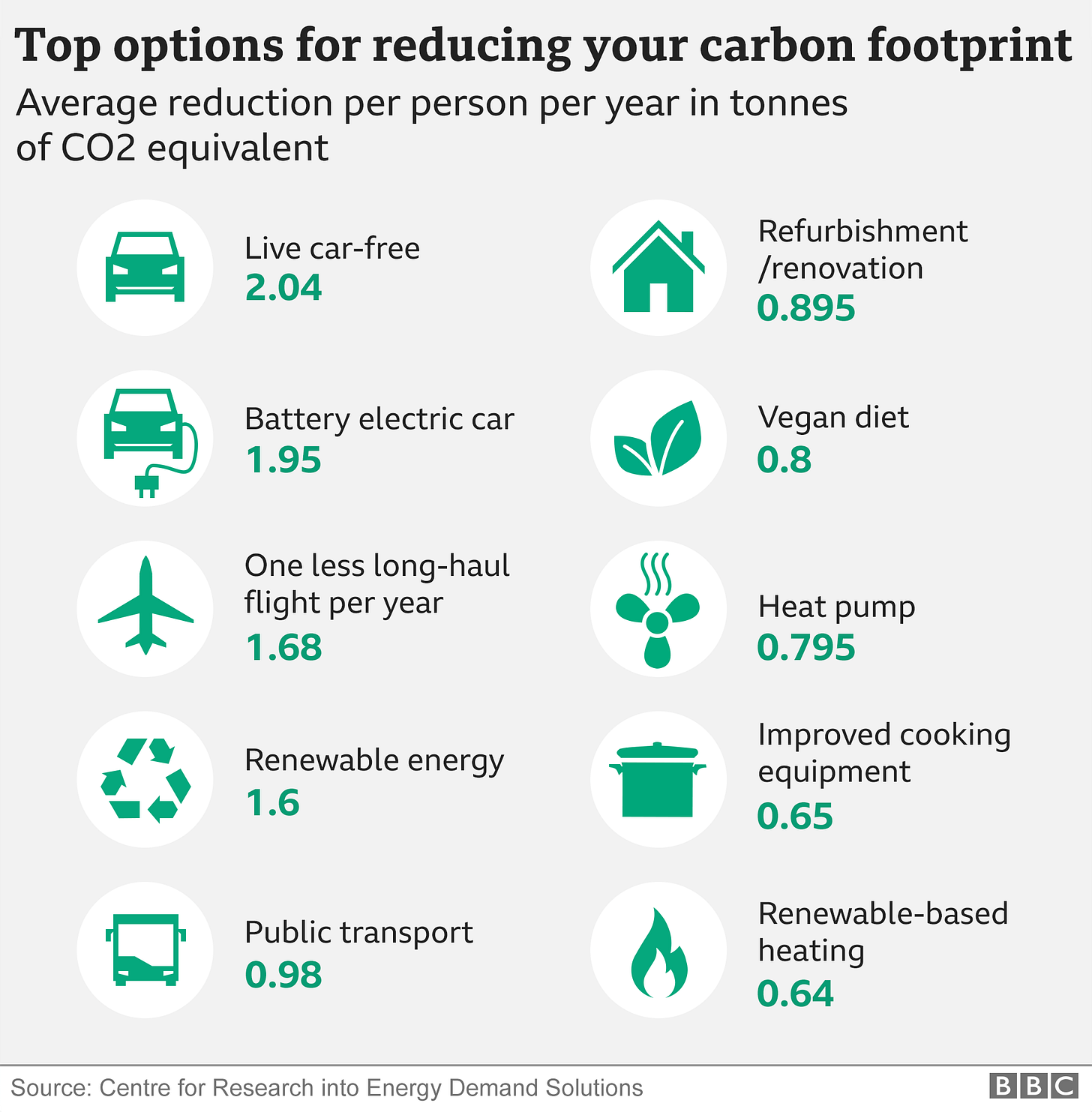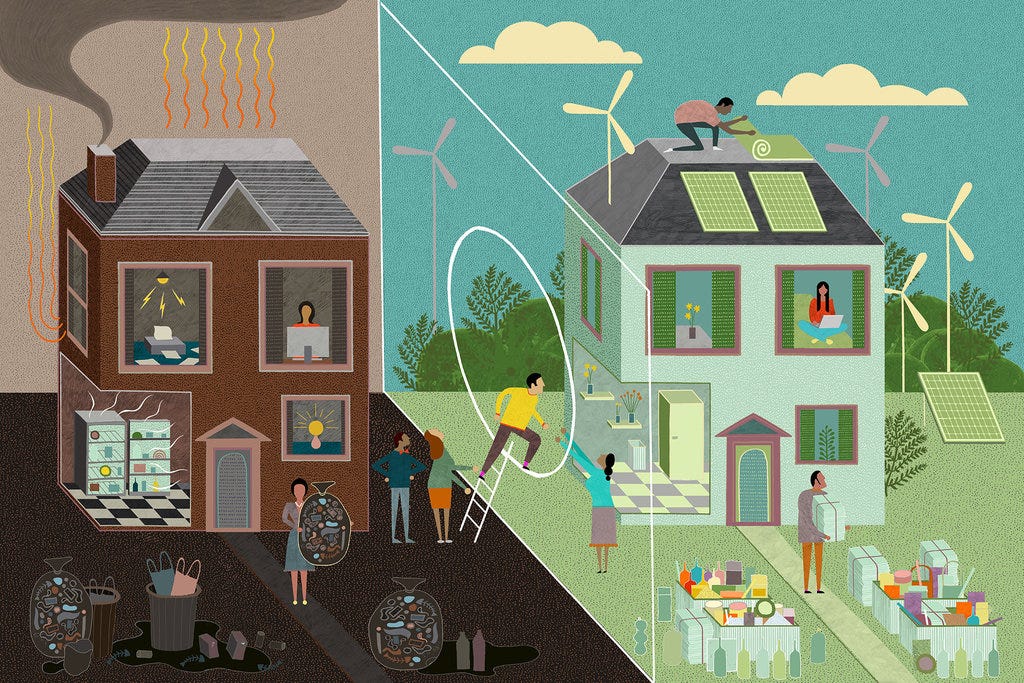43+ ways to reduce my own carbon footprint 🍃 without making myself a clown on social media.
Tricks & services you can use to reduce your environmental footprint. + Become an Atlas Impact ambassador and help us scout innovations making our civilization more sustainable every day.
Last week or so for Earth Day, lots of people were proudly sharing on Facebook about how cool they were by being “Carbon Neutral” having bought a few trees through some NGOs donations and others.
Nothing bad about planting a tree once a year for Earth Day, but this week, without talking about cash investments in climate tech let’s look at how we can do a little bit to be responsible the whole year, with simple actions.
You will need more than that to greenwash your t-shirt
The simplest way to define ecological footprint is the amount of the environment necessary to produce the goods and services necessary to support a particular lifestyle.
The real cost of a single T-shirt is around 2,700 liters of water to produce the cotton needed. I have 20 of them. One t-shirt would generate 4.07 kg of CO2 over the course of its life. Interestingly, about 60% of that environmental impact is accounted for by post-consumer care – things like washing and drying (we've seen that percentage range from 40% to 70% in other studies). On the other hand, Data shows that overall, 75 percent of the Earth's land surface is experiencing human impacts, putting millions of species at definitive extinctions.
How planting 1 tree for Earth day could really make an impact on my past 29 years of life, the trash produced, water consumed, become alleviated so easily? Got me thinking and do some researches.
So, how to do a little bit more than spending 10$ on a tree planting NGO once a year, while not making myself look like a clown to my surrounding? Here is what I got so far, feel free to comment and suggest other ideas you may have. We might get a good plan for next year Earth Day. Or even take these actions the whole year, maybe…
First, calculate your own carbon footprint
Your carbon footprint is the number of greenhouse gases—including carbon dioxide, methane, nitrous oxide, fluorinated gases, and others—that you produce as you live your life. The Deep Decarbonization Pathways Project determined that in order to hold the global temperature rise to 2˚C or less, everyone on earth will need to average an annual carbon footprint of 1.87 tons by 2050. Currently, the average U.S. per capita carbon footprint is 18.3 tons, basically for 1 US citizen. By comparison, China’s per capita carbon emissions are 8.2 tons. All humans on this planet all have a ways to go to get to 1.87 tons.
Calculate your carbon footprint at carbonfootprint.com to find out how you’re doing. The EPA’s carbon footprint calculator can show how much carbon and money you will save by taking some of these steps.
Now, here are some of the easiest ways you can start to shrink your carbon footprint, without making yourself a clown to your friends, family, and co-workers.
Food
1. Reduce the amount of food you throw away. Average Americans throw away about 40% of the food they buy. It’s bad. Don’t do that.
2. Get creative. Reuse leftovers instead of tossing them. C’mon, you got all the time in the world to learn to cook during the global lockdowns.
3. Doggie bag. Take home half of oversized restaurant servings. That can reduce your food monthly spending by half.
4. If you love meat like me, try to be a vegan hybrid for a while ( it would get your six-packs). Mix some meals with vegan meals once in a while, this is not gonna kill you.
5. Eat less land stuff and more sea stuff. Fishes and crustaceans have incredible energy to protein conversion ratios compared to beef, chicken, or pork. Check out my precedent article about aquaculture to get more info.
Shopping

6. Look for a fairtrade, or similar logo. This indicates your clothes were made sustainably. Take a look at this transparency index from the organization Fashion Revolution.
7. How to Dress Sustainably? Explore buying vintage or recycled clothing, vintage is trendy.
8. Donate old clothes. Better yet, use those too old to be donated for other purposes, like sewing projects or cleaning rags. Some animal shelters will take old sheets and towels for bedding material as well.
9. Wash your clothing in cold water. The enzymes in cold water detergent are designed to clean better in cold water. Doing two loads of laundry weekly in cold water instead of hot or warm water can save up to 500 pounds of carbon dioxide each year.
10. Bring your own reusable bag when you shop.
11. Try to avoid items with excess packaging - particularly for food delivery
12. If you’re in the market for a new computer, opt for a laptop instead of a desktop. Laptops require less energy to charge and operate than desktops.
13. If shopping for appliances, lighting, office equipment, or electronics, look for Energy Star products, which are certified to be more energy efficient.
14.Support and buy from companies that are environmentally responsible and sustainable. Here is a list of companies to buy from and not to buy from
HOME
15. Do an energy audit of your home. This will show how you use or waste energy and help identify ways to be more energy-efficient.
16. Avoid cleaning products with harmful chemicals. Consider using EPA Safer Choice or other certified green cleaning products that are biodegradable and non-toxic. These products will not only deep clean your laundry but will also remove residue you didn’t know was there.
17. Line-Dry Your Clothes. One dryer load uses 5 times more electricity than washing – by simply line-drying your clothes, you can save 1/3 of their carbon footprint.
18. Change incandescent light bulbs (which waste 90 percent of their energy as heat) to light-emitting diodes (LEDs). Though LEDs cost more, they use a quarter of the energy and last up to 25 times longer. They are also preferable to compact fluorescent lamp (CFL) bulbs, which emit 80 percent of their energy as heat and contain mercury.
19. Switch lights off when you leave the room and unplug your electronic devices when they are not in use. Pull the plug of your chargers & TVs when going on holiday.
20. Turn your water heater down to 120˚F. This can save about 550 pounds of CO2 a year, and also, you will save a lot of money
21. Keep taking long showers, just Installing a low-flow showerhead to reduce hot water use can save 350 pounds of CO2.
22. If you have a garden, install a water recycler for your shower/baths to water the plants in your garden. You will feel much better seeing your plants grow after taking a relaxing bath.

23. Find ways to beat the heat without air conditioning. A simple fan can sometimes do the job. Lower your thermostat in winter and raise it in summer. Use less air conditioning in the summer; instead opt for fans, which require less electricity. And check out these other ways too.
24. Invest in solar energy for your home. Going solar has been proven to reduce your carbon footprint, and is an investment that will pay itself back over time. With millionsn of super cheap Solar Panels arriving from China. now is the perfect opportunity for everyone to make an impact by saving our planet.
25. Sign up to get your electricity from clean energy through your local utility or a certified renewable energy provider. Green-e.org can help you find certified green energy providers.
26. Stream movies through your smart TV, not your game console. Smart TVs and their plugins use just a few watts to stream movies, Mr. Horowitz said, but if you use your game console, energy use is about 10 times higher, because they aren’t optimized to play films.
27. Don't set your fridge and freezer temperatures lower than necessary. The United States Department of Energy recommends around 35 to 38 degrees Fahrenheit for the fresh food compartment and 0 degrees for freezers. (And unplug that old fridge in the garage when you don't need it to chill anything.)
28. Consider growing your own garden for simple things (Salad, Tomato, Onions, Carrots) you eat every day. The ecological footprint of transporting your South American tomatoes can be several tons.
29. Recycle, Americans generate roughly 258 million tons of trash a year, 169 million tons of which end up in landfills and incinerators, according to a 2014 report from the E.P.A. That year, American’s recycled and composted 89 million tons of municipal solid waste — this saved the same amount of energy as generated by 25 million homes. But much of the waste that can be recycled still ends up in landfills. Recycle paper. Recycle paper and steel and tin cans. Before throwing it away, ask: Can I re-use or repair this? Donate working electronics. Recycle broken electronics. Some advertising here for one of the startups in Atlas Society doing great stuff…
30. Discover new ways to live a sustainable lifestyle. Separating and composting your food scraps can be the first step into a world of sustainability. When you begin to separate your waste into three categories–compost, recycling, and landfill, you become more mindful about what is in all three categories.
31. Installing automation technology provides an easy way for homeowners to monitor their device usage, which can save you money and wasted energy, and also reduce your carbon footprint.
Transportation
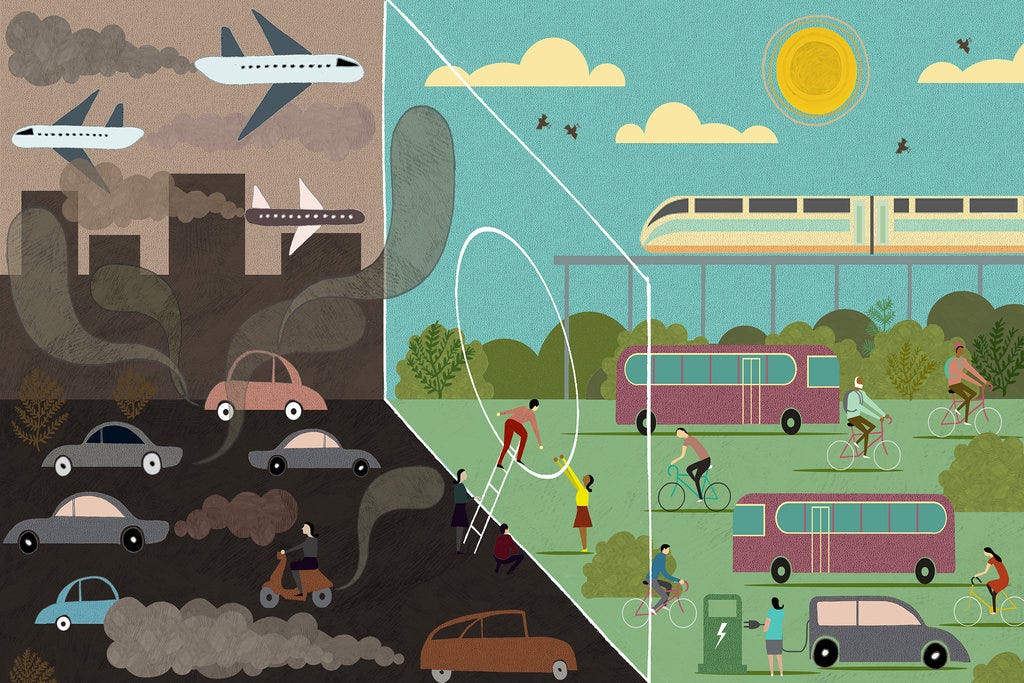
32. Why do you need your own car in a crowded city? Take Uber, Walk, take public transportation, carpool, rideshare, or bike to your destination when possible. This not only reduces CO2 emissions but also lessens traffic congestion and the idling of engines that accompanies it.
33. If you must drive, avoid unnecessary braking and acceleration. Some studies found that aggressive driving can result in 40 percent more fuel consumption than consistent, calm driving.
34. Remove any extra weight from the car. An additional 100 pounds in your car can reduce gas mileage by up to 2%. That’s a min. 2% decrease in your yearly spending.
35. Be a bit more strategic with your errands. When doing errands, try to combine them to reduce your driving, and also save a lot of personal time to play video games and watching Netflix.
36. Use traffic apps like Waze to help avoid getting stuck in traffic jams.
37. On longer trips, turn on the cruise control, which can save gas.
38. If you’re shopping for a new car, consider purchasing a hybrid or electric vehicle. But do factor in the greenhouse gas emissions from the production of the car as well as its operation. Some electric vehicles are initially responsible for more emissions than internal combustion engine vehicles because of manufacturing impacts, but they make up for it after three years. This app rates cars based on their mileage, fuel type, and emissions from both the production of the car and, if they are EVs, from generating the electricity to run them.
39. If you fly for work, then do a Zoom call instead if possible. air travel is probably responsible for the largest part of your carbon footprint.
40. Fly economy class. Business-class is responsible for almost three times as many emissions as economy because, in the economy, the flight’s carbon emissions are shared among more passengers; first-class can result in nine times more carbon emissions than the economy class.
41. If you can’t avoid flying, offset the carbon emissions of your travel. That’s minimum a 1.5 Tons of carbon that you won’t have to offset and a 43$ win... See how below.
Carbon offsets
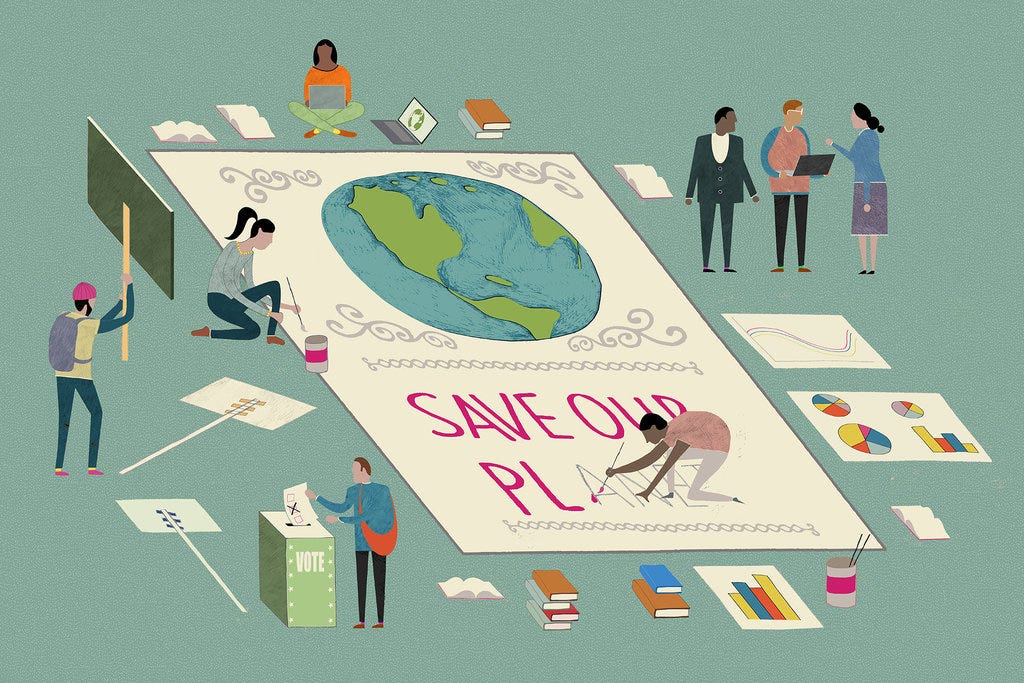
42. Offset your carbon before Earth Day: A carbon offset is an amount of money you can pay for a project that reduces greenhouse gases somewhere else. If you offset one ton of carbon, the offset will help capture or destroy one ton of greenhouse gases that would otherwise have been released into the atmosphere. Offsets also promote sustainable development and increase the use of renewable energy.
This calculator estimates the carbon emissions of your flight and the amount of money needed to offset them. For example, flying economy roundtrip from New York to Los Angeles produces 1.5 tons of CO2; it costs $43 to offset this carbon footprint.
You can purchase carbon offsets to compensate for any or all of your other carbon emissions as well.
Get politically active
43. Finally—and perhaps most importantly since the most effective solutions to climate change require governmental action—vote! Become politically active and find representatives who think like you, then let them know you want them to take action to phase out fossil fuel use and decarbonize the country as fast as possible.
Know your facts. Understanding the science of climate change will help you talk to your family, friends, and local representatives about the issue with confidence.
Find local climate action groups or meetups in your area. Attending these meetings will help to keep you abreast of the way you can help in your community.
Speak to your local representative. Suggest things your city or town can do to reduce its carbon footprint, like developing a town action plan, improving recycling, and adopting green energy policies.
Vote on policies that protect the environment. Use your vote to curb climate change.
Power the sustainable tech disruption
Atlas is supporting entrepreneurs and teams working on creating a sustainable civilization through making greener products, companies, and cities.
Help Atlas identifies & support local solutions making your reality more sustainable!
As an Impact Ambassador, you can join Atlas Groups, Submit sustainable tech innovations in your surroundings so our society will find ways to support them, and you can join an Atlas Society Chapter to embody change in your city.
Sources: This article has been crafted by reading different sources. Here, here, here, here, and here.


